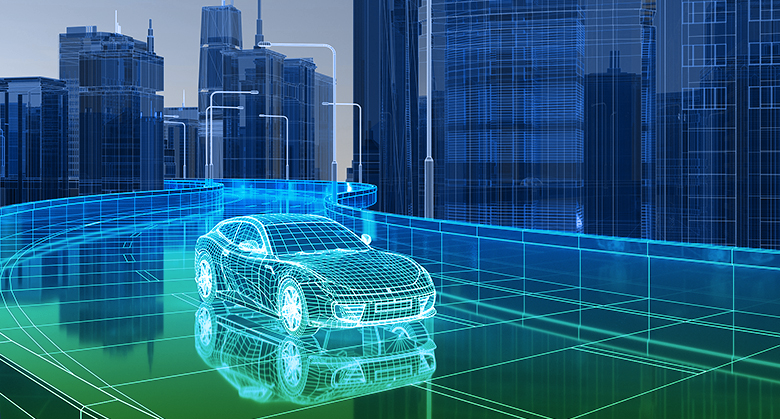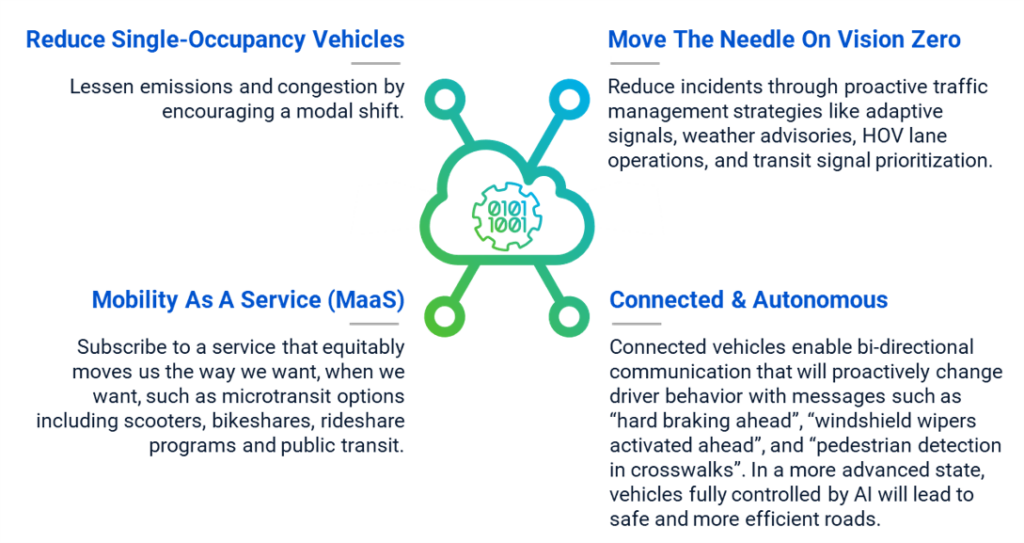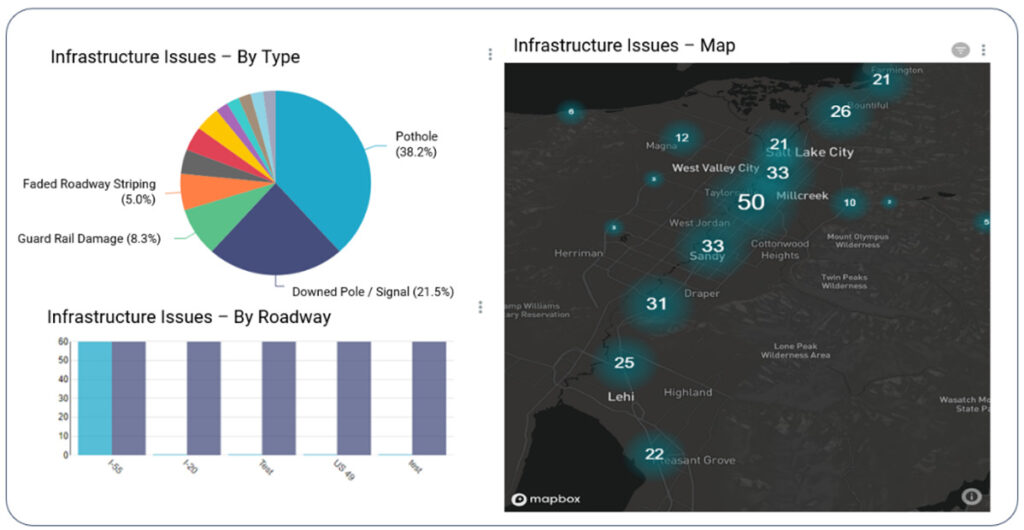The Future Of Transportation: How AI Is Changing The Way We Move

What if we were able to ask transportation management software questions about traffic patterns, the availability of other modes of transportation, parking options, and traffic incidents and their causes to better understand the past, present, and future of mobility in a matter of minutes?

The artificial intelligence (AI) market is expected to grow from $200B in 2023 to $1.2T by 2030, which implies AI-enabled technology will be universal and integrated into almost every facet of our lives (Thormundsson, 2023). AI capabilities are already making a significant impact on how we live and move throughout our communities. For example, the integration of AI into smart mobility platforms is improving the management, efficiency, sustainability, and safety of our transportation networks.
By using the power of AI, transportation stakeholders are empowered to make informed, data-driven decisions in real-time, resulting in timely actions. AI enhances smart mobility platforms through the following methods:
- Significant time savings through automation and guidance
- Evolution from reactive to predictive insights
- Comprehensive multi-dimensional views with a system of systems approach

Significant Time Savings Through Automation And Guidance
AI fused with natural language allows us to move away from the maxim “created by engineers for engineers” to a flexible and intuitive system that delivers timely information and guidance to the right transportation professional, whether they are executive directors, managers, operators, maintenance personnel, or a driver, public transit commuter, or field maintenance worker.
For example, an engineering manager within a city or statewide department of transportation (DOT) can use AI-enabled software to ask, “Show me a time when a snowstorm caused intense braking and sliding at intersections as seen by the following data sources: AVL data from the vehicle, stop bar violations and near miss analytics. Show me a comparison of when a snowstorm starts versus a temperature drop of 15 degrees in one hour.” Based on the data, the engineer can create an automated workflow by telling the system, “In the future, when the temperature drops 15 degrees in one hour and there is moisture on the road, increase yellow light time at all arterial intersections by five seconds. Provide a report with before and after analysis, including an analysis on the impacts to crosswalk conflicts and near miss collisions.”
Evolution From Reactive To Predictive Insights
Through the evolution of analytics, AI is taking us from insight, “what happened?”, to foresight, “what will happen?” or “how can we predict what will happen?”. By using anticipatory intelligence, we transition from reactive to proactive action to improve safety response times. Over time, we can correlate crash and weather datasets with real-time, travel time data to trigger alerts when conditions warrant intervention and provide guidance on the optimal placement of safety personnel and EMS vehicles to potentially save more lives.

As transportation agencies have grown and ubiquitous computing is available at edge, the number of intelligent transportation system (ITS) and Internet of Things (IoT) devices maintained by state agencies has grown substantially. With limited budgets for maintenance, it’s increasingly important to know exactly where funding and efforts should be focused to realize the maximum benefit. When applied to asset management, artificial intelligence can greatly improve maintenance efficiencies by using various IoT outputs, aggregated data streams and foundational data science principals, to identify when devices, or groups of devices, are starting to malfunction. This data, when analyzed over a period of time, can provide insight into which devices are failing and create prioritized maintenance schedules to ensure critical device components are kept online and operational. Using geospatial algorithms, AI can also identify and prioritize areas where clusters of devices require maintenance, enabling highway departments to group work efforts and manage repairs and preventative maintenance more efficiently. Furthermore, physical infrastructure can be monitored using connected vehicle data, LiDAR, and video analytics to identify unsafe driving conditions such as missing or damaged roadway signs, potholes, or damaged guardrails. Ultimately, by tracking conditions and performance and mapping to equipment specifications, these rich datasets of ITS and infrastructure assets can eliminate the guesswork of maintenance planning and provide the necessary insights planning officials need when budgeting for preventative maintenance or seeking to extend the life of agency assets.
Comprehensive Multi-Dimensional Views With A System Of Systems Approach
Working in data silos and within disparate systems make AI capabilities nearly impossible. It will certainly limit interoperability and data-driven action.To address this challenge, agencies must implement an integrated platform in which data from disparate systems can be aggregated, visualized and managed in one place. By utilizing AI’s ability to efficiently analyze and optimize vast amounts of aggregated data for a holistic view of activity and valuable insights that may not be immediately apparent, public-sector agencies can quickly provide information to their customers. For example, measuring “improved sustainability” can include data from air quality, electrification, and smart lighting projects, while “improved safety” can include video analytics, weather monitoring, and data from vehicles, such as sudden braking. Each one of those outcome areas have vast quantities of data, which, when combined with mobility outcomes data such as multi-movement counts, travel time reporting, or smart parking, it becomes difficult to understand as a holistic system. Additionally, by analyzing historical data and trends, AI can help stakeholders understand the current state, highlight potential intervention needs, and examine the efficacy of interventions.

We are now at an inflection point where we can progress from “smart” to “wise” using AI in transportation. For years, our team has delivered AI-enabled capabilities, bringing innovative solutions such as dynamic ramp metering using fuzzy logic, and responsive traffic signal control with AI inferencing and incident detection using historical traffic data trends and modeling. As we move forward, our smart mobility experts are building advanced capabilities into the iNET® Smart Mobility Platform using cloud services such as Azure Cognitive Services, Azure OpenAI, Azure ML and Computer Vision. By using regression models and training them with transportation related data, such as speed, weather, and volumes, the incident detection engine can learn and detect anomalous conditions that help drive decisions before incidents occur. In addition, using trained video detection models, the system can survey snapshots of video over time to detect deteriorating infrastructure, potholes, and intersections with high rates of near-miss collisions. Finally, as we move into this new world of interactive AI bots, building a conversational “personal assistant” within the iNET® application will help guide operators on required actions, interpret thousands of pages of operational manuals within seconds for quick recall, and provide an easy interface into system functions, thus lessoning the overall training burden on operations staff. The potential to recognize these positive interventions within traffic operations at the holistic level down to the intersection level, will lay the groundwork for applying these technologies across a variety of states, regions, cities, and neighborhoods.
As we stand on the precipice of a new age, the role of AI in revolutionizing transportation becomes increasingly clear. Our journey began at the inception of this transformative technology, and we have remained pioneers driving value and fostering acceptance within the sector. Our commitment to harnessing the power of AI enables our clients and cities to tap into unprecedented levels of efficiency, safety, and sustainability. This is the dawn of a new era, and we are leading the charge towards a smarter, greener future.